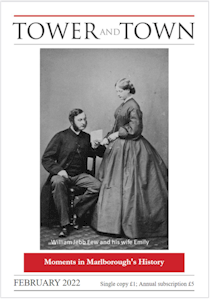

Tower and Town, February 2022 (view the full edition) (view the full edition)The Great Fire Of Marlborough, 28 April 1653The Great Fire of Marlborough occurred in a turbulent decade in what was a turbulent century. The English Civil War started on the 22nd August 1642. At the start of the war, in December, Marlborough was besieged by a royalist army who overwhelmed the garrison which supported parliament. Many of the defeated citizens, including the mayor, were taken in chains, in bitter winter weather, to the royalist capital at Oxford. After the King’s defeat in the civil war and execution in 1649, the monarchy was abolished by the Rump Parliament. The republic with Cromwell as Lord Protector lasted just ten years until the Restoration of the monarchy in 1660. The Borough of Marlborough was staunch in its support for parliament and this is shown by our town maces which were commissioned during the republican era with republican symbols such as oak branches. Royalist symbols were added at the restoration of the monarchy in 1660 and the wording round the top of the mace states ‘1660: The Freedoms of England by the Grace of God restored’. It looks now as if the Borough of Marlborough was staunch in its support for the restoration of the monarchy! However Marlborough had always supported parliament during the conflict and that is why when Marlborough suffered the disaster of the Great Fire in 1653 Cromwell called for a national campaign for the relief of the distress. The fire started around 41 to 47 High Street at the west end on the lower side near the Wellington Arms pub in the yard of a tanner who was drying oak bark used in the tanning process. The fire quickly spread in the space of three hours because of a strong west wind and over 150 houses were destroyed including all of those on the south and north sides of the High Street to the east, the Shambles buildings in the middle of the High Street, Kingsbury Street and the Green including St Mary’s Church*. In 1653, England was at war with Holland and at the time of the fire, Dutch POWs were being marched through Marlborough. These POWs acted with great courage in rescuing people from burning buildings. In recognition of this, when the Town Council put up a blue plaque in the 1990’s, the Dutch ambassador was invited to the unveiling and sent his chargé d’affaires. Other postscripts to the fire are that the Committee for the Relief of Marlborough met in Saddlers’ Hall in the City of London. The iconic building of The Merchant’s House in the High Street was the house of Thomas Bayly, a wealthy silk merchant who lost everything in the fire. His claim on the relief funds allowed him to rebuild the house as we see it today. There were two more bad fires in Marlborough, in 1679 and 1690 after which an Act of Parliament banned thatched roofs within the boundaries of the Borough. * Damage estimated at £70,000. Compare this with the value of the whole High Street in the late 1800’s as being about £30,000. David Chandler |